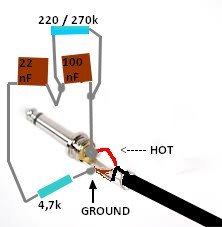Fender Greasebucket:
https://www.premierguitar.com/media-library/image.png?id=27534202&width=377&quality=80
Distant memories tell me that it was meant to reproduce the behavior of a tone pot + a very old paper in wax cap, whose capacitance would have drifted and ESR rised.
To me, the most important part of this circuit is the 4,7k resistor to ground, preventing the pot to actually reach 0/10.
Practically, a Greasebucket circuit @ 0/10 is like a tone pot with a 18nF cap and set a wee bit above 0/10.
To the OP: I've no reliable sample to share but the circuit can be emulated externally with two resistors, two caps and some alligator clips.
It requires the original tone pot of the test guitar to stay @ 10/10 and to use a guitar cable with one of its male jack shells unscrewed, giving access to hot and ground. Then the components can be wired like below, with twisted legs and alligator clips instead of solder blobs for a temporary attempt:

FWIW, a 18nF cap in series with a 4,7k resistor would make the sound very similar. Same thing for a 22nF in series with a 4,7k. In fact, a normal tone pot separated from ground by a 4,7k would mimic what makes the singularity of Greasebucket circuits IMO / IME. YMMV.
FWIW.
